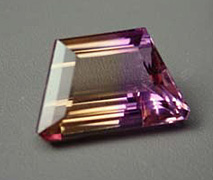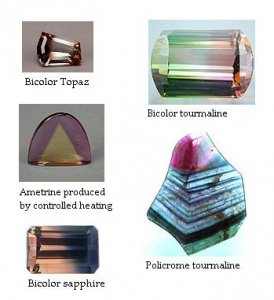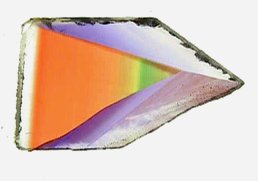You are using an out of date browser. It may not display this or other websites correctly.
You should upgrade or use an alternative browser.
You should upgrade or use an alternative browser.
Ametrine???
- Thread starter IceFind
- Start date
- Status
- Not open for further replies. Please create a new topic or request for this thread to be opened.
- Joined
- Nov 21, 2002
- Messages
- 2,326
Hello Jared,
First I would like to say that I congratulate you on recognizing such a beautiful stone.Ametrine is relatively inexpensive and is a beautiful gem to stick into a custom pendant or ring...The following is a summation of articles I have read and a compilation of knowledge I have gained through reading several text and currently pursuing my GG certificate through the GIA. There are many online sources to seek out the information you are inquiring about...
At the location in Bolivia, both amethyst and citrine (Ametrine) are thought to have been crystallizing simultaneously during formation due to distinct temperature changes. The color difference is due to the different oxidation state of the element iron.. The slight difference in temperature between the crystallizing surfaces of the quartz is what causes the 2 unique colors in Ametrine. The surfaces were of slightly higher temperature and thereby crystallizing as citrine (yellow color) in one area while other surfaces were slightly cooler and crystalizing as amethyst (purple color) in another area of the stone. The direction and/or sidethe heat source (example would be a thermal vent) was being applied to the crystal is responsible for the splitting of the 2 colors. Changes in pressure would also affect the temperature at which citrine formed instead of amethyst. This delicate balance of the temperature, pressure and chemical environment of the crystallizing ametrine quartz all had to be maintained while crystallization proceeded giving ametrine it’s bi-colored appearance.
When you have one picked out or have a stone in mind throw up a picture and let us now a price and you will be sure to get more feedback....
-Josh Rioux
Sitka, Alaska
Aspiring Gemologist


First I would like to say that I congratulate you on recognizing such a beautiful stone.Ametrine is relatively inexpensive and is a beautiful gem to stick into a custom pendant or ring...The following is a summation of articles I have read and a compilation of knowledge I have gained through reading several text and currently pursuing my GG certificate through the GIA. There are many online sources to seek out the information you are inquiring about...
Ametrine is a variety of quartz and is a bi-colored stone displaying the colors found in amethyst (purple) and citrine (yellow/gold). The colors are found in the same crystal of quartz. The color defining element which gives this gem it color is iron. Ametrine is considered a durable gemstone and the depth & contrast of colors is dominantly displayed in gems of larger size. One of the most well known sources of this gem is the Anahi mine in Bolivia. Ametrine began to appear on the market in the early 1980’s when material from this mine started surfacing in the retail market. Ametrine can be artificially produced in quartz by irradation and/or heat treating...
/www.pricescope.com/idealbb/images/smilies/3.gif[/img]
At the location in Bolivia, both amethyst and citrine (Ametrine) are thought to have been crystallizing simultaneously during formation due to distinct temperature changes. The color difference is due to the different oxidation state of the element iron.. The slight difference in temperature between the crystallizing surfaces of the quartz is what causes the 2 unique colors in Ametrine. The surfaces were of slightly higher temperature and thereby crystallizing as citrine (yellow color) in one area while other surfaces were slightly cooler and crystalizing as amethyst (purple color) in another area of the stone. The direction and/or sidethe heat source (example would be a thermal vent) was being applied to the crystal is responsible for the splitting of the 2 colors. Changes in pressure would also affect the temperature at which citrine formed instead of amethyst. This delicate balance of the temperature, pressure and chemical environment of the crystallizing ametrine quartz all had to be maintained while crystallization proceeded giving ametrine it’s bi-colored appearance.
When you have one picked out or have a stone in mind throw up a picture and let us now a price and you will be sure to get more feedback....
-Josh Rioux
Sitka, Alaska
Aspiring Gemologist


- Joined
- Aug 29, 2003
- Messages
- 15,808
Hi! To bad I have not seen this post earlier... Still:
Actually, most crystals dispaly and aray of colors but this is usually perceived as a flaw: the dreaded 'color zoning'which slashes the price of sapphire and colored diamonds and others. Only sometimes this mix and match is recognized for its beauty: ametrine is a clasic case, so is bi or tri or multi-color tourmaline, and teh rather rare combination of natural blue and pink/orange in precious topaz. Sometimes sapphires are cut as bicolor gems as oposed to the more economically correct choice to cut separate gems from each color area of the rough. Ametrine is a special case: sometimes it occurs naturally, but, since by heating amethyst (violet) become cytrine (yellow), one can produce ametrine by controlled heating. These stones are completrly undistinguishable from the natural ones (more or less-as below- believable though) and, given the low price, few would bother with the distinction (no one I know).
If this is not confusing, than, well, see below what I mean...

Actually, most crystals dispaly and aray of colors but this is usually perceived as a flaw: the dreaded 'color zoning'which slashes the price of sapphire and colored diamonds and others. Only sometimes this mix and match is recognized for its beauty: ametrine is a clasic case, so is bi or tri or multi-color tourmaline, and teh rather rare combination of natural blue and pink/orange in precious topaz. Sometimes sapphires are cut as bicolor gems as oposed to the more economically correct choice to cut separate gems from each color area of the rough. Ametrine is a special case: sometimes it occurs naturally, but, since by heating amethyst (violet) become cytrine (yellow), one can produce ametrine by controlled heating. These stones are completrly undistinguishable from the natural ones (more or less-as below- believable though) and, given the low price, few would bother with the distinction (no one I know).
If this is not confusing, than, well, see below what I mean...

- Joined
- Nov 21, 2002
- Messages
- 2,326
Good Post Valeria,
Yes, the main source of natural non-heat treated stones come from Bolivia. It is common for the stones to be heat treated to induce more distinct colors and separation.
The growth of ametrine in the laboratory demands that the oxidation state of iron be carefully controlled and also that the rate of growth falls within a critical set of conditions.
It is even possible to prepare crystals with iron in all three oxidation states in a single crystal as this slice of a Russian synthetic crystal shows. (the 2 main oxidation states producing Yellow/orange,purple)
Val check this out........Tri colored Ametrine synthetically grown....

Yes, the main source of natural non-heat treated stones come from Bolivia. It is common for the stones to be heat treated to induce more distinct colors and separation.
The growth of ametrine in the laboratory demands that the oxidation state of iron be carefully controlled and also that the rate of growth falls within a critical set of conditions.
It is even possible to prepare crystals with iron in all three oxidation states in a single crystal as this slice of a Russian synthetic crystal shows. (the 2 main oxidation states producing Yellow/orange,purple)
Val check this out........Tri colored Ametrine synthetically grown....

- Status
- Not open for further replies. Please create a new topic or request for this thread to be opened.
Share:
Featured Topics
The Ultimate Guide to Men’s Wedding Bands: Metals, Fit & Finish
The Ultimate Guide to Men’s Wedding Bands: Metals, Fit & Finish - 06/27
Chipped Diamonds: Causes, Risks, and What You Should Do About It
Chipped Diamonds: Causes, Risks, and What You Should Do About It - 06/27







300x240.png)